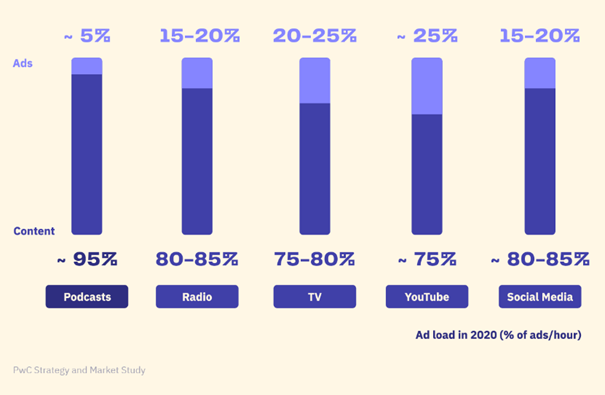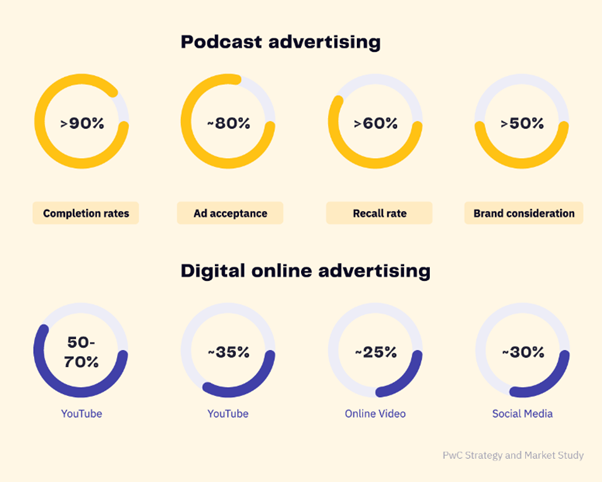The Audible Revolution of Podcasting and Podcast Advertising
Podcasting and the audiences they reach has expanded exponentially in recent years as adoption rises amidst an ever-expanding catalogue of content and resourcing afforded to the medium. Once coined an “audible revolution” in 2004, podcasting has drastically altered the way we consume audio entertainment. The industry becoming saturated with professional and amateur productions alike, spanning every broad and niche interest imaginable; from comedy, news, sports, TV and film to true crime, history, and sneaker culture.
Figures project there will be 424.2 million podcast listeners globally in 2022, with the industry estimated to be worth USD $95 billion by 2028. And where there is a mass audience, opportunity for advertising is rife. A recent Forbes article explaining:
“Estimated podcast ad spend was USD $800 million in 2020 and will more than double to USD $1.7 billion by 2024, an annual growth of nearly 20%. A survey from Westwood One and Advertiser Perceptions found increasingly advertisers are using podcasts as a part of their media strategy. In 2015, 10% of marketers said they would likely advertise in a podcast over the next six months, when asked the same question in 2020, the number spiked to 37%.”
So, what makes podcast advertising increasingly appealing to marketers?
Beyond the growing listener base, a key advantage podcasts have over competing channels (such as TV and radio) is the attention of audiences. Acast (the global podcast hosting platform) describes them as the “the most intimate medium, reaching the most engaged listeners”. This can largely be attributed to the lower ad load compared to others, meaning less clutter (competing messages), more brand capacity and ultimately, greater likelihood of audience reception.

Supported by a new study commissioned by the Guardian which found “65% of listeners paid attention to podcast adverts – more than adverts on TV at 39% and adverts on the radio at 38%.”
Also working in favour of podcast advertising is the perceived authenticity of messaging. Audiences are more likely to trust what they are hearing given they have opted in to listening and generally have high perceptions of the program with which they are engaged. This lends credence to the implementation of host-read ads, which acts as a form of influencer advertising, as Forbes explains “[they] leverage the host’s connection with their audience… using the host’s familiarly to prompt a listener to purchase a product”. Such ads work best when they form part of the podcast itself, as Adcast puts it, seamlessly integrating advertising into the narrative and overall storytelling, making them feel less intrusive.

Given the plethora of podcasters producing content, marketers are readily able to target categories or programs which best suit their messaging, enabling them to direct communications to the right audiences. Hubspot uses the example “if you place an ad about your B2B recruiting service on a podcast that discusses human resources, listeners who own or manage a B2B company, or human resources employees, might want to use your service to make their jobs easier”
Not only this, but technologies are also now being developed to further aid marketers. Launched in March of 2022, using artificial intelligence, Acast’s advanced speech-to-text transcription technology known as conversational targeting allows brands to go beyond what is currently possible in terms of targeting. Where previously advertising was only able to be placed based on a specific genre or podcast series, conversational targeting enables advertisers to target individual episodes and certain conversations which may span a variety of categories. Acast use the example of a food delivery service
“[They] can target individual episodes of a podcast where the hosts discuss what they’re having for dinner, or their love of cooking — even if that happens to be a podcast from a quite different genre. Podcasts and their ad inventory were previously tagged only in relation to a full-series genre. So now being able to identify the episode-level context of the conversation actually happening — and that this one cover categories like “food” and “cooking” — highlights new, untapped opportunities for relevant brands”
Inherent audience engagement, authenticity and targeting are just some of the core benefits to podcast advertising and help drive its effectiveness as an advertising medium. With the podcast audio revolution in full swing, new and creative ways to maximise efforts through this channel could be essential for marketers moving forward.




